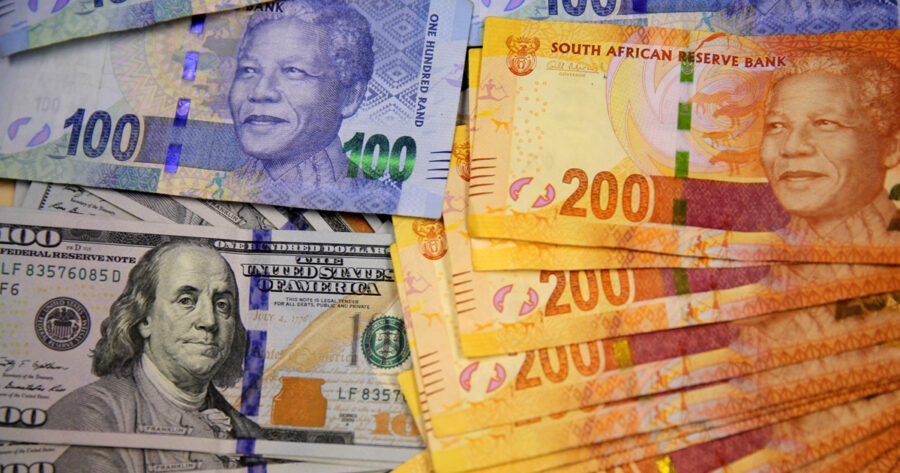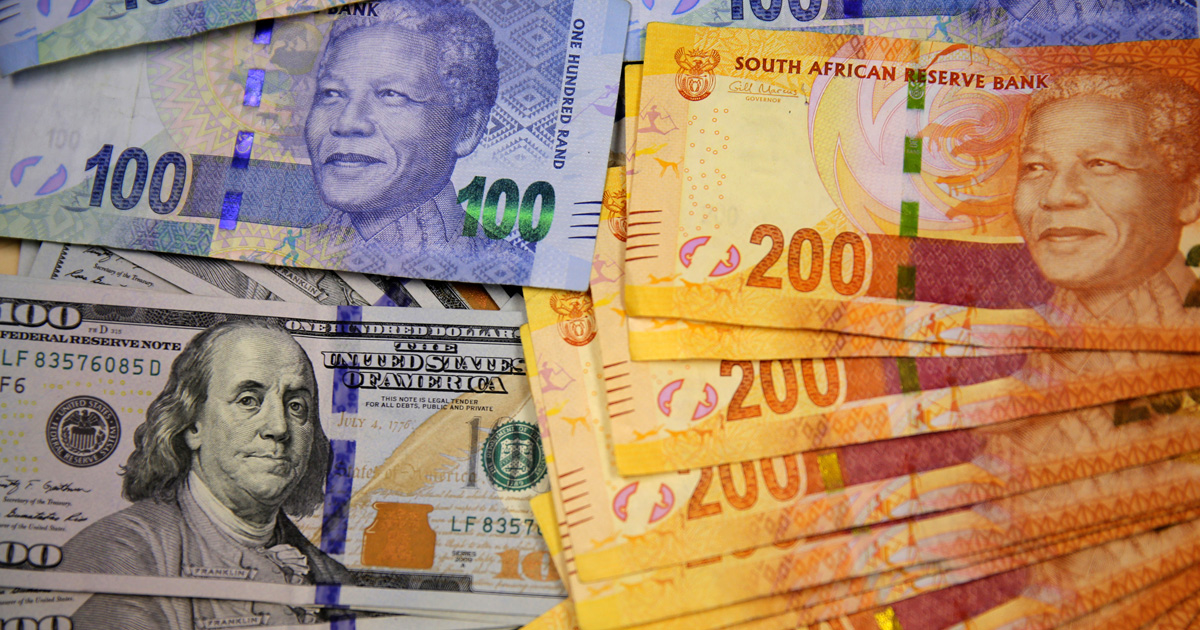
South African rand tumbled as risk-off sentiment spikes
Reuters: The South African rand tumbled over 1% on Tuesday, extending Monday’s losses as global risk-off sentiment increased. At 0905 GMT, the rand traded at 18.0325 against the dollar, about 0.85% weaker than its previous close. SOUTH AFRICAN RAND TUMBLED It had weakened to as much as 18.0884 earlier in the day. The dollar last […]

Reuters: The South African rand tumbled over 1% on Tuesday, extending Monday’s losses as global risk-off sentiment increased. At 0905 GMT, the rand traded at 18.0325 against the dollar, about 0.85% weaker than its previous close.
SOUTH AFRICAN RAND TUMBLED
It had weakened to as much as 18.0884 earlier in the day. The dollar last traded at 102.150 around 0.3% firmer against a basket of global currencies. “After the rand’s strong advance through June, it was always vulnerable to a slight correction. This has been triggered by risk-off market sentiment globally, as seen in emerging market currency weakness,” Danny Greeff, co-head of Africa at ETM Analytics told Reuters.
Its weakness on Monday came as China’s economic position rang alarm bells and “dampened risk appetite”, said Andre Cilliers, currency strategist at TreasuryONE. At around 1200 GMT, the National Association of Automobile Manufacturers of South Africa will release the country’s vehicle sales data for July. On the Johannesburg Stock Exchange, the blue-chip Top-40 index last traded 0.05% stronger than its closing level on Monday.
ALSO READ: Who are the richest South Africans in the world today? – 1 August 2023
South Africa’s benchmark 2030 government bond was also slightly weaker, with the yield up 7 basis points to 10.285%. “South Africa does not look like an attractive investment destination at the moment and will need to maintain higher bond yields to keep itself funded with foreign capital,” Greeff added.
BRITISH POUND
Reuters: The pound fell to a three-week low on Tuesday as investors digested economic data and looked towards an uncertain Bank of England interest rate decision on Thursday. Sterling has risen around 6% this year as the BoE has hiked interest rates to deal with stubbornly high inflation, and as the dollar has slipped as U.S. price pressures have cooled. It peaked at a 15-month high of $1.314 in the middle of July before falling after data showed British inflation came in lower than expected at 7.9% in June. The pound was down 0.54% to $1.277 on Tuesday, the lowest since July 10.
Meanwhile, the euro was up 0.24% against the pound at 85.86 pence. “Sterling’s decline isn’t out of lockstep with the general grind lower in G10 FX today against the dollar,” said Simon Harvey, head of foreign exchange analysis at Monex. “It seems as if markets are just taking a bit of risk off of the board ahead of key U.S. earnings and the Bank of England decision on Thursday, and Friday’s U.S. payrolls report, all of which pose credible risks of derailing the prevailing risk rally.”
ALSO READ: Chief Land Claims Commissioner urges checking land claim status
The dollar index – which tracks the currency against six peers – was up 0.44% at 102.35 on Tuesday. Chris Turner, head of markets at ING, said weak global manufacturing data, driven by China’s faltering economy, was weighing on sentiment and boosting the safe-haven dollar. Survey results released on Tuesday showed that British factory output fell at the fastest pace in seven months in July, part of a trend around the world. Separate data from mortgage lender Nationwide showed that British house prices dropped by the most since 2009 in the 12 months to July as rising interest rates took a toll on the market.
Traders think there is a 62% chance that the BoE hikes interest rates by 25 basis points this week, which would take them to 5.25%. They see a 38% chance of a bigger 50 bp hike, according to pricing in derivatives markets. “With inflation falling, house prices falling and economic sentiment gloomy, a 25 bp hike with a warning there could yet be more to come would seem sensible,” said Kit Juckes, chief global FX strategist at Societe Generale, in a note to clients. “But given where expectations are that leaves GBP vulnerable this week. 25bp from the Bank, and solid US data, could easily drag GBP/USD back below $1.25. Market pricing shows investors expect the BoE to lift rates to around 5.8% by early 2024. That’s down sharply from early July when rates were expected to rise to 6.4% or higher.
U.S. DOLLAR
Reuters: The dollar struggled to make headway on Wednesday after a cut on the U.S. government’s top credit rating by Fitch raised questions about the country’s fiscal outlook, though it drew some support from a relatively resilient run of economic data. Rating agency Fitch on Tuesday downgraded the United States to AA+ from AAA in a move that drew an angry response from the White House and surprised investors, coming despite the resolution two months ago of the debt ceiling crisis. That nudged the greenback lower, lifting the euro toward $1.10. The single currency last gained 0.12%, after earlier touching a session-high of $1.1020. Sterling steadied at $1.27755, while the U.S. dollar index rose 0.07% to 102.07, having slipped broadly in the wake of the Fitch news. “We don’t think the Fitch decision is that material. Certainly, we’ve seen the market move a little bit this morning but over the near term, I don’t think it’s going to be a longer lasting driver,” said Rodrigo Catril, senior currency strategist at National Australia Bank.
ALSO READ: Who is the richest person in the world today? Top 10 list – 2 August 2023
The dollar also found some support from Tuesday’s economic data that showed U.S. job openings remained at levels consistent with tight labour market conditions, even as they fell to the lowest level in more than two years in June. A separate report suggested U.S. manufacturing might be stabilising at weaker levels in July amid a gradual improvement in new orders, though factory employment dropped to a three-year low. Elsewhere, the Japanese yen rose nearly 0.5% to 142.67 and looked set to reverse three straight sessions of losses, with traders still assessing the implications of the Bank of Japan’s move on Friday to loosen its grip on interest rates.
BOJ deputy governor Shinichi Uchida said on Wednesday that the central bank’s decision was aimed at making its massive stimulus more sustainable and not a prelude to an exit from ultra-low interest rates. “I think the market is still trying to get their head around what this whole thing means,” said NAB’s Catril. The Australian dollar fell 0.36% to $0.65895, having earlier slid to its lowest level since June, extending a sharp fall from the previous session after the Reserve Bank of Australia on Tuesday held interest rates steady and signalled that it might be done tightening.
The New Zealand dollar similarly tumbled and was last 0.62% lower at $0.6112, after data on Wednesday showed the country’s jobless rate hit a two-year high in the second quarter, easing the pressure on its central bank to continue raising rates. Kelly Eckhold, chief economist at Westpac, said in a note on Wednesday that he now sees the Reserve Bank of New Zealand raising rates in November instead of August, as recent data “have likely not been strong enough to overcome the RBNZ’s strong bias” to keep rates on hold.
ALSO READ: Newspaper front pages from around the world, 2 August 2023
GLOBAL MARKETS
Reuters: Asian stocks and U.S. Treasury yields declined on Wednesday after ratings agency Fitch unexpectedly downgraded the United States’ top-tier sovereign credit rating. MSCI’s broadest index of Asia-Pacific shares slid 1.9%. Japan’s Nikkei dropped by 1.8%, while Australian shares tumbled 2.3%. China’s mainland benchmark and Hong Kong’s fell by 0.9% and 2.2%, respectively, as some investors booked profits in the absence of concrete and forceful measures by Beijing to shore up a faltering economy. Asian stocks were also weighed down by declines on Wall Street overnight. U.S. stock futures, the S&P 500 e-minis , pointed 0.2% lower on Wednesday.
In early European trades, the pan-region Euro Stoxx 50 futures were down 0.7%. German DAX futures and FTSE futures fell 0.8% and 0.5% respectively. Fitch cut the United States by one notch to AA+ from AAA, citing fiscal deterioration, a decision announced after the Wall Street close on Tuesday. U.S. 10-year Treasury yields declined by about 2 basis points to 4.025% in Tokyo. “Most of the Asia turmoil this morning and the Treasury yields move is triggered by the Fitch decision,” said Manishi Raychaudhuri, head of Asia Pacific equity research at BNP Paribas. “It’s kind of a short-term knee-jerk reaction, so we will have to wait and watch for how this pans out.”
ALSO READ: WATCH: Older person’s SASSA grants collection day [VIDEO]
Raychaudhuri said the Fitch move might actually lead to increased demand for U.S. Treasuries, at least in the near term, given U.S. corporate debt “might be viewed as being more risky now than it used to be”. Investors counterintuitively fled to the relative safety of sovereign debt from riskier equity markets. Treasuries, whose yields fall when prices rise, were also bought when Standard & Poor’s cut the U.S. top “AAA” rating by one notch to “AA-plus” in 2011. Tony Sycamore, an analyst with IG, said apart from the Fitch move, there has been some disappointing data in the U.S. and China and some weaker-than-expected earnings, and people are taking money off the table. Managers who can only hold debt with AAA ratings from at least two agencies, for example, need to sit down and think what to buy instead of the U.S. treasuries, he said.
The U.S. dollar moved lower against a basket of major currencies immediately after the announcement, but was up 0.1% as of the Asian afternoon. Japan’s 10-year bond yield hit a fresh nine-year peak on Wednesday as investors continued to test the Bank of Japan’s tolerance for higher yields following Friday’s surprise policy tweak. While the investor reaction to the downgrade was relatively contained, it has injected some uncertainty into financial markets. “This basically tells you the U.S. government’s spending is a problem. It’s an unsustainable budget situation because the economy can’t even grow its way out of this problem going forward,” said Steven Ricchiuto, U.S. chief economist, Mizuho Securities. “Therefore, they’re going to have to either tackle it or accept the consequences of potential further additional downgrades.”
Looking beyond the Fitch downgrade, the main area of focus will still be central banks, corporate earnings and, in China specifically, stimulus prospects and geopolitical issues, said BNP’s Raychaudhuri. The United States publishes fresh data on jobless claims and unemployment later this week. Oil prices gained on Wednesday, trading near their highest since April, after industry data showed a much steeper-than-expected draw last week in U.S. crude oil inventories. West Texas Intermediate crude futures ticked up 0.9% to $82.07 while Brent crude rose to $85.60 per barrel. Gold was slightly higher, trading at $1,948.29 per ounce.
ALSO READ: Rand Water announces 17 hours planned shutdown next week
